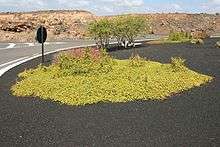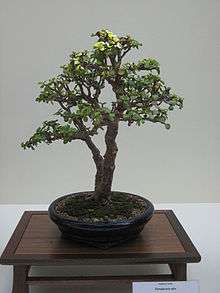Portulacaria afra
Portulacaria afra (known as elephant bush, dwarf jade plant, porkbush and spekboom in Afrikaans) is a small-leaved succulent plant found in South Africa. These succulents commonly have a reddish stem and leaves that are green, but also a variegated cultivar is often seen in cultivation. They are simple to care for and make easy houseplants for a sunny location. In frost-free regions they may be used in outdoor landscaping.
| Portulacaria afra | |
|---|---|
| Scientific classification | |
| Kingdom: | Plantae |
| Clade: | Tracheophytes |
| Clade: | Angiosperms |
| Clade: | Eudicots |
| Order: | Caryophyllales |
| Family: | Didiereaceae |
| Genus: | Portulacaria |
| Species: | P. afra |
| Binomial name | |
| Portulacaria afra | |
Description
It is a soft-wooded, semi-evergreen upright shrub or small tree, usually 2.5–4.5 metres (8–15 ft) tall. Similar in appearance to the unrelated "jade plant" Crassula ovata (family Crassulaceae), P. afra has smaller and rounder pads and more compact growth (shorter internodal spaces, down to 1.5 millimetres (0.059 in)). It is much hardier, faster growing, more loosely branched, and has more limber tapering branches than Crassula once established.[1]
The genus Portulacaria has been shown to be an outlier, relatively unrelated to the other genera in the family, which are all restricted to small ranges in the arid far west of Southern Africa.[2]
Distribution and habitat
It is very widespread in the east of South Africa (including Eswatini). In this moist climate, it is relatively rare, and tends to favour dryer rocky outcrops and slopes.
It is also found in much denser numbers in the dryer southern Cape. Here it occurs from the Little Karoo of the Western Cape, eastwards up until the thicket vegetation of the Eastern Cape.[3] Spekboom is found most prolifically in the Albany thickets, a woodland ecoregion, which locally is often called noorsveld, after the high number of succulent Euphorbia species, which are often called noors plants. [4]
Cultivation and uses

In the wilds of South Africa, large plants do survive the winter frosts by growing dense enough to provide their own natural cover. Drought-tolerant and fire-resistant, it will endure desert sun and heat once established, which the jade plant will not. Portulacaria is a common landscape plant in Phoenix, Arizona and southern California. Cuttings root very easily in most potting media.
Ornamental

It is popular as a specimen for bonsai, and as a hardy xeriscaping plant. Several varieties exist - some bred in cultivation, others naturally occurring:[5]
- "Limpopo": A variety with much larger leaves. It is the natural form from the far north of the species' range.
- "Prostrata": A low-lying, decumbent form that is frequently used as a ground-cover.
- "Aurea": A compact, upright form with rounded leaves that go bright yellow in the sun.
- "Foliis variegatus": A variegated form.
- "Medio-picta": Variegated with a lighter centre.
Food source
In Southern Africa it is commonly eaten, usually as one component of a salad or a soup. It should not to be confused with the jade plant, which is mildly toxic.
Carbon sequestration
It is capable of either C3 or CAM carbon fixation, depending on factors such as the season and the age of the leaves.[3] It can sequester a maximum of 15.4 t CO2 ha-1yr-1.[6] The South African government’s Working for Ecosystems programme proposes restoring a million hectares (2.5 million acres) of spekboom thicket.[7][8]
References
Citations
- "Portulacaria afra Monograph". Pyramid Dancer. Retrieved 2011-01-20.
- Bruyns, Peter V.; Oliveira-Neto, Mario; Melo-de-Pinna, Gladys Flavia; Klak, Cornelia (2014). "Phylogenetic relationships in the Didiereaceae with special reference to subfamily Portulacarioideae". Taxon. 63 (5): 1053–1064. doi:10.12705/635.36. ISSN 0040-0262.
- Lonnie J. Guralnick, Patricia A. Rorabaugh & Zac Hanscom, III (1984). "Seasonal shifts of photosynthesis in Portulacaria afra (L.) Jacq". Plant Physiology. 76 (3): 643–646. doi:10.1104/pp.76.3.643. PMC 1064348. PMID 16663899.CS1 maint: multiple names: authors list (link)
- Becking, David. "Portulacaria afra | Tree SA". Retrieved 2019-07-21.
- "Portulacaria afra". PlantZAfrica.com. Retrieved 2015-10-05.
- Mills, Anthony J.; Cowling, Richard M. (2014). "How Fast Can Carbon Be Sequestered When Restoring Degraded Subtropical Thicket?". Restoration Ecology. 22 (5): 571–573. doi:10.1111/rec.12117. ISSN 1061-2971.
- Matthews, Alexander (3 February 2020). "How shrubs can help solve climate change". BBC Future. BBC. Retrieved 4 February 2020.
- "South Africa's Environmental Programmes" (PDF). Retrieved 4 February 2020.
Further reading
- Paviour, Sarah-Jane (2014). Carbon Sequestration and Trading Potential in Semi-Arid South Africa : A Karoo Case Study (MA thesis). Stellenbosch University. hdl:10019.1/95794.CS1 maint: ref=harv (link)
| Wikimedia Commons has media related to Portulacaria afra. |